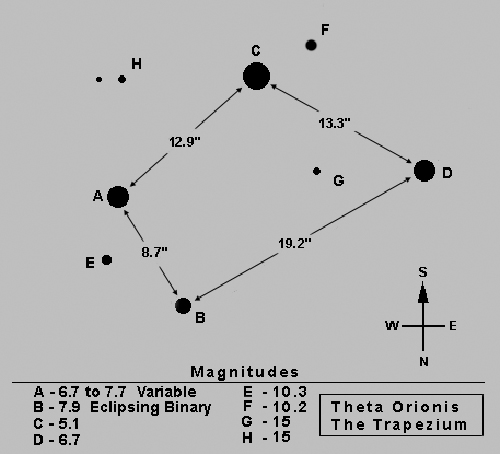
Directly in front of M42 is a small grouping of hot O and B type stars known as the trapezium which shine between 5th and 8th magnitude. This grouping represents the 4 brightest members of an extended cluster of several thousand young stars many of which lie unseen within the opaque gas and dust. The bright trapezium grouping represents the cluster core where stars are packed so tight they exceed the stellar concentration of our suns vicinity some 20,000 times. Stars within the trapezium are separated by only 0.12 light years whereas our sun's nearest neighbor is 4 light years away.
The thin blister of ionized gas we call the orion nebula would be invisible if not for the four trapezium stars which together produce all of the ultraviolet radiation illuminating the nebula. The trapezium stars, also called the theta-1 group, are classified from west to east as theta 1A, B, C, and D ( spectral classes B1, B0, O6, B0.5) all located within a tight space spanning only 10,000 astronomical units. The trapezium stars are about 1 million years old and number 4 bright stars. Actually the number is 11 taking into consideration that all members are multiple star systems. If one includes stars seen at only infrared wavelength then the trapezium cluster probably contains over 500 young stars. The highly visible cluster members are hot, massive O and B type stars. All contribute energy to the massive nebula however Theta-1 C, a massive O6 giant, is by far the most prodigious contributor, supplying more than 99% of the ultraviolet energy. Theta-1 C is an enormous star of 40 solar masses and a surface temperature of 40,000 degrees Kelvin. If the earth were located within the trapezium cluster the night sky would be dominated by extraordinarily bright stars. Theta-1 C would shine 10 times brighter than the full moon and the other trapezium members would be at least as bright as the full moon.
The other three members of the trapezium are far less dominant although each weighs in at over 10 solar masses. Amazingly Theta-1 C is 210,000 times more luminous than our sun and produces a gargantuan stellar wind 100,000 times the flow rate of our sun. High resolution images taken by HST show that theta 1C's powerful winds are evaporating dusty disks which surround newly formed stars in the vicinity. These disks might have been the precursors of new planets but will not likely survive the harsh environment imposed by the massive star. Theta-1 C will in all likelihood meet its fate as a great supernova in a few million years.
